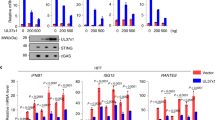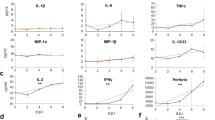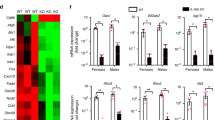Abstract
The HIV-1 accessory gene product Vpr can influence viral pathogenesis by affecting viral replication as well as host cell transcription and proliferation. We have investigated the effects of Vpr on host cell activation and confirm that it influences cellular proliferation. However, we have also found that Vpr modulates T-cell receptor (TCR)-triggered apoptosis in a manner similar to that of glucocorticoids. In the absence of TCR-mediated activation, Vpr induces apoptosis whereas in its presence, Vpr interrupts the expected induction of apoptosis. This regulation of apoptosis is linked to Vpr suppression of NF-κB activity via the induction of IκB, an inhibitor of NF-κB. Further, Vpr suppresses expression of IL-2, IL-10, IL-12, TNFα and IL-4, all of which are NF-κB-dependent. The effects of Vpr could be reversed by RU486. Our finding that Vpr can regulate NF-κB supports the hypothesis that some aspects of viral pathogenesis are the consequence of cell dysregulation by Vpr.
This is a preview of subscription content, access via your institution
Access options
Subscribe to this journal
Receive 12 print issues and online access
$209.00 per year
only $17.42 per issue
Buy this article
- Purchase on Springer Link
- Instant access to full article PDF
Prices may be subject to local taxes which are calculated during checkout
Similar content being viewed by others
References
Cohen, E.A. et al. Identification of HIV-1 Vpr product and function. J. Acquired Immune DeficSyndr. 3, 11–18 (1990).
Heinzinger, N.K. et al. The HIV-1 Vpr protein influences nuclear targeting of viral nucleic acids in non-dividing cells. Proc. Natl. Acad. Sci. USA 91, 7311–7315 (1994).
Fletcher, T. et al. Nuclear import and cell cycle arrest functions of the HIV-1 Vpr protein are encoded by two separate genes in HIV-2/SIVsm. EMBO J. 15, 6155–6165 (1996).
Connor, R.I., Chen, B.K., Choe, S., Landau, N.R. Vpr is required for efficient replication of human immunodeficiency virus type 1 in mononuclear phagocytes. Virology 206, 936–94 (1995).
Levy, D.N., Rafaeli, Y., & Weiner, D.B. Vpr protein increases cellular permissiveness to human immunodeficiency virus replication and reactivates virus from latency. J. Virol. 69, 1243–1252 (1995).
Levy, D.N. et al. Induction of cell differentiation by human immunodeficiency virus 1 vpr. Cell 72, 541–550 (1993).
He, J. et al. Human immunodeficiency virus type 1 protein R (Vpr) arrests cells in the G2 phase of the cell cycle by inhibiting p34cdc2 activity. J Virol. 69, 6705–6711 (1995).
Rafaeli, Y., Levy, D.N., & Weiner, D.B. The glucocorticoid receptor type II complex is a target of the HIV-1 vpr gene product. Proc. Natl. Acad. Sci. USA 92, 3621–3625 (1995).
Parrillo, J.E., Fauci, A.S. Mechanisms of glucocorticoid action on immune processes. Annu. Rev. Pharmacol. Toxicol. 19, 179–201 (1979).
Gonzalo, J.A., Gonzalez-Garcia, A., Martinez, C. & Kroemer, G. Glucocorticoid-mediated control of the activation and clonal deletion of peripheral T cells in vivo. J. Exp. Med. 177, 1239–1246 (1993).
Wyllie, A.H. Glucocorticoid-induced thymocyte apoptosis is associated with endogenous endonuclease activation. Nature 284, 555–556 (1980).
Von Knebel Doeberitz, M. et al. Glucocorticoid hormones reduce the expression of major histocompatibility class I antigens on human epithelial cells. Eur. J. Immunol. 20, 35–40 (1990).
Fauci, A.S. Host factors and the pathogenesis of HIV-induced disease. Nature 384, 529–534 (1996).
Byron, K.A., Varigos, G. & Wootton, A. Hydrocortisone inhibition of human interleukin-4. Immunology 77, 624–626 (1992).
Gillis, S. et al. Glucocorticoid-induced inhibition of T cell growth factor production. I. The effect of mitogen-induced lymphocyte proliferation. J. Immunol. 123, 1624–1631 (1979).
Philibert, D. RU38486: An original multifaceted antihormone in vivo, in Adrenal Steroid Antagonism. (ed. Agarwal, M.K.) 77–101 (de Gruyter, Berlin and New York, 1984).
Tobler, A. et al. Glucocorticoids downregulate gene expression of GM-CSF, NAP-1/IL-8, and IL-6 but not of M-CSF in human fibroblasts. Blood 79, 45–51 (1992).
Ucker, D.S. Cytotoxic T lymphocytes and glucocorticoids activate an endogenous suicide process in target cells. Nature 327, 62–64 (1987).
Helmberg, A. et al. Glucocorticoid-induced apoptosis of human leukemic cells is caused by the repressive function of the glucocorticoid receptor. Embo J. 14, 452–460 (1995).
Grimm, S. et al. Bcl-2 down regulates the activity of transcription factor NF-kappa B induced upon apoptosis. J. Cell Biol. 134, 13–23 (1996).
Lin, K.I. et al. Thiol agents and Bcl-2 identify an alphavirus-induced apoptotic pathway that requires activation of the transcription factor NF-kappa B. J. Cell Biol. 131, 1149–1161 (1995).
Fotedar, A. et al. Fine specificity of antigen recognition by T cell hybridoma clones specific for poly-18: A synthetic polypeptide antigen of defined sequence and conformation. J. Immunol. 135, 3028–3033 (1985).
Lu, W. et al. Glucocorticoids rescue CD4 T lymphocytes from activation-induced apoptosis triggered by HIV-1: Implications for pathogenesis and therapy. AIDS 9, 35–42 (1995).
Zhao, Y. et al. Calcineurin activation protects T cells from glucocorticoid-induced apoptosis. J. Immunol. 154, 6346–6354 (1995).
Beg, A.A. & Baltimore, D. An essential role of NF-kappaB in preventing TNFa induced cell death. Science 274, 782–784 (1996).
Van Antwerp, D.J. et al. Suppression of TNFα induced apoptosis by NF-kappaB. Science 274, 787–789 (1996).
Wang, C., Mayo, M.W. & Baldwin, A.S., Jr. TNF and cancer therapy-induced apoptosis: Potentiation by inhibition of NF-kappaB. Science 274, 784–787 (1996).
Auphan, N. et al. Immunosuppression by glucocorticoids: Inhibition of NF-κB activity through induction of 1κB synthesis. Science 270, 286–290 (1996).
Scheinman, R.I., Cogswell, P.C., Lofquist, A.K. & Baldwin, A.S., Jr., Role of transcriptional activation of IKBα inmediation of immunosuppression by glucocorticoids. Science 270, 283–286 (1996).
Mahalingam, S., Velpandi, A., Patel, M., Kieber-Emmons, T. & Weiner, D.B. Nuclear import, virion incorporation and cell cycle arrest/differentiation are mediated by distinct functional domains of HIV-1 Vpr. J. Virol. 71, 6339–6347 (1997).
Paul, W.E. & Seder, R.A. Lymphocyte responses and cytokines. Cell 76, 241–251 (1994).
Arya, S.K., Wong-Stall, F. & Gallo, R.C. Dexamethasone-mediated inhibition of human T cell growth factor and γ-interferon messenger RNA. J. Immunol. 133, 273–276 (1984).
Graziosi, C. et al. Lack of evidence for the dichotomy of TH1 and TH2 predominance in HIV-infected individuals. Science 265, 248–252 (1994).
Graziosi, C. et al. Kinetics of cytokine expression during primary human immunodeficiency virus type 1 infection. Proc. Natl. Acad. Sci. USA 93, 4386–4391 (1996).
Poli, G. & Fauci, A.S. Role of cytokines in the pathogenesis of HIV disease. in Human Cytokines: Their Role in Disease and Therapy. (eds. Aggarwal, B.B. & Puri, R.K.) 421–449 (Blackwell Scientific Publ., Cambridge, MA, 1995).
Levy, D.N. et al. Serum vpr regulates productive infection and latency of human immunodeficiency virus type 1. Proc. Natl. Acad. Sci. USA 91, 10873–10877 (1994).
Ameisen, J.C. & Capron, A. Cell dysfunction and depletion in AIDS: The programmed Cell death hypothesis. Immunol. Today 12, 102–105 (1991).
Finkel, T.H. et al. Apoptosis occurs predominantly in bystander cells and not in productively infected cells of HIV-and SIV-infected lymph nodes. Nature Med. 1, 129–134 (1995).
Lang, S.M. et al. Importance of vpr function of rhesus monkeys with simian immunodeficiency virus. J. Virol. 67, 902–912 (1993).
Wang, B. et al. Gene defects clustered at the C-terminus of the vpr gene of HIV-1 in long-term nonprogressing mother and child pair: In vivo evolution of vpr quasispecies in blood and plasma. Virology 223, 224–232 (1996).
Rogel, M.E., Wu, L.I. & Emerman, M. The human immunodeficiency virus type 1 vpr gene prevents cell proliferation during chronic infection. J. Virol. 69, 882–888 (1995).
Jowett, J.B.M. et al. The human immunodeficiency virus type 1 vpr gene arrests infected T cells in the G2 + M phase of the cell cycle. J. Virol. 69, 6304–6313 (1995).
Mahalingam, S. et al. Mutagenesis of the putative a-helical domain of the Vpr protein of human immunodeficiency virus type 1: Effect on stability and virion incorporation. Proc. Natl. Acad. Sci. USA 92, 3794–3798 (1995).
Fujita, T. et al. Independent modes of transcriptional activation by the p50 and p65 subunits of NF-kappa B. Genes Dev. 6, 775–787 (1992).
Author information
Authors and Affiliations
Rights and permissions
About this article
Cite this article
Ayyavoo, V., Mahboubi, A., Mahalingam, S. et al. HIV-1 Vpr suppresses immune activation and apoptosis through regulation of nuclear factor κB. Nat Med 3, 1117–1123 (1997). https://doi.org/10.1038/nm1097-1117
Received:
Accepted:
Issue Date:
DOI: https://doi.org/10.1038/nm1097-1117
This article is cited by
-
HIV-1 Accessory Protein Vpr: Relevance in the pathogenesis of HIV and potential for therapeutic intervention
Retrovirology (2011)
-
The intriguing Cyclophilin A-HIV-1 Vpr interaction: prolyl cis/trans isomerisation catalysis and specific binding
BMC Structural Biology (2010)
-
Mechanisms of HIV-associated lymphocyte apoptosis: 2010
Cell Death & Disease (2010)
-
Modulating the activity of the channel-forming segment of Vpr protein from HIV-1
European Biophysics Journal (2010)
-
Modulation of HIV-1 virulence via the host glucocorticoid receptor: towards further understanding the molecular mechanisms of HIV-1 pathogenesis
Archives of Virology (2010)



